Creativity is a business necessity. However, it involves more than simply asking for more creative ideas or hiring “creative” people: you have to create a culture that supports creativity. Creativity is fundamental to inviting creativity into the workplace who we are as human beings, and should not be confused with being artistic; everyone can be creative – engineers, lawyers, CLOs, physicians, linguists, chefs, shipping managers, photographers, etcetera.
Problems arise when new employees are told to be creative, but then confined to “do things the way they’ve always been done.” On the other hand, many executives lament the abundance of “creative solutions” that lack practical application or an available team capable of production. Inviting Creativity into the Workplace. So how do you find balance between compliance, innovation, and execution?
It is helpful to allocate a percentage of time devoted to creative activities. This will allow for the brain to be relaxed enough to find solutions in complex problems. In fact, companies like 3M and Google regularly allocate time where employees can take walks, play games that do not require a lot of attention, or to simply lay back in a comfy couch and let their minds wander to wherever it wants to go. 3M’s “15 Percent Rule,” where employees can devote up to l5% of their time pursuing ideas that both interest them and may have potential value for the company, has had significant, tangible results: 25% of 3M’s revenue comes from products that are less than 5 years old (citation). That’s a lot of innovation.
Allowing for creative expression within your organization will result in your staff being happier and more productive, as you are tapping into their “hobby” mindset – in which those bored at work, go home to work on projects that make them feel inspired. Ideally, you could create an environment that would be stimulating enough while they are at work. In this interview, Rick Lozano from Rackspace describes his frustrations and solutions for producing a healthy work environment that encourages creativity.
How do you invite creativity into your workplace and how do you balance it against the demands of deadlines?
Here are some helpful links on how to inspire creativity in the workplace and transform your culture to allow for more innovative thinking:
http://www.hongkiat.com/blog/unleash-creativity-workplace/
https://www.amazon.com/How-Fly-Horse-Invention-Discovery/dp/0804170061
https://www.amazon.com/Big-Magic-Creative-Living-Beyond/dp/1594634726
http://www.huffingtonpost.com/alison-a-quirk/fostering-a-culture-of-cr_b_7615498.html
http://www.trendreports.com/article/boost-creativity-in-the-workplace
Transcript
Rick Lozano: When I think about engagement in the workforce, and we talk about the culture. Culture is a really important part of the equation because, in addition to the stories that people tell and the visual representation of this particular organization, cultures is also the way things get done. We hire people because they’re creative. We say, “John is really talented. Ooh, he’s creative.” And then we get them into the work environment, we say, “Okay, now do your job like this.” It’s engaging to be creative in the work that you do. And everyone is naturally creative. And we have the opportunity to say, “Hey, within these guidelines, if it works, if it’s aligned, if it’s effective, go for it.” It feels good to create. It’s an intrinsic motivator. When I play the guitar, I want to show that work with somebody. It’s the difference between owning something versus creating something.
Creativity is innovation. It’s a business necessity. And if we’re not allowing and creating a culture where we’re telling people, “Hey, it’s okay, go for it.” People are going to do the work they’ve always done, and we’re not going to be able to innovate. There’s strategic value in open space. And when we give people an opportunity, say 20% time, 10% time, it allows people to engage in creative thought. And at that point they can create anything. And there’s a phrase I love and it says, “In the beginner’s mind, there are infinite possibilities. And in the expert’s mind, there are few.” We have a lot of experts at work, and I think every now and then we need to back up and say, “Hey, what can we do? What can we create?” Within certain guidelines, anything is possible. And when you give people that opportunity, when you open that door, we’re going to get better solutions. We’re going to have better products. We’re going to have faster innovation, and people are going to feel better coming to work every single day.
